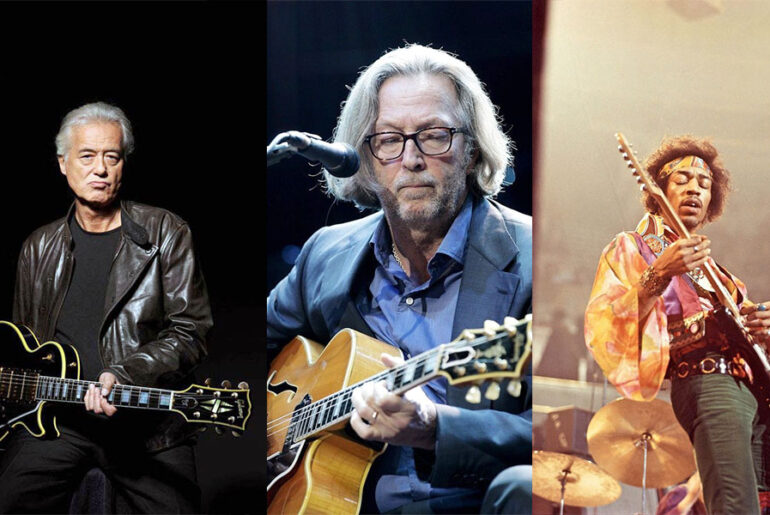The best guitar players of all time have shaped music history through extraordinary talent, innovative techniques, and emotional expression that continues inspiring musicians worldwide. These legendary artists have transcended genres, pushing the boundaries of what’s possible with six strings and forever changing how we perceive the guitar as an instrument. Determining the greatest requires examining technical skill, creative innovation, and lasting cultural impact that defines the best guitar players of all time.
The Undisputed Legends
Jimi Hendrix – The Revolutionary Pioneer
Jimi Hendrix consistently tops virtually every “greatest guitarist” list compiled by music publications and critics. His revolutionary approach to the electric guitar transformed rock music forever. Hendrix pioneered the use of feedback, distortion, and effects pedals as musical elements rather than technical flaws. His performances at Woodstock and the Monterey Pop Festival became legendary moments that redefined live music.
Hendrix’s influence extends far beyond his brief four-year recording career. He demonstrated that the guitar could be both a rhythmic and lead instrument simultaneously, creating a wall of sound that was previously impossible. His ability to blend blues, rock, funk, and psychedelic elements created a new musical language that guitarists still study today.
Jimmy Page – The Architect of Hard Rock
Jimmy Page ranks among the top three guitarists according to major music publications, and for good reason. As Led Zeppelin’s guitarist and primary songwriter, Page crafted some of rock’s most iconic riffs and solos. His versatility spans from delicate acoustic fingerpicking on “Stairway to Heaven” to the thunderous power of “Whole Lotta Love.”
Page’s production techniques were as revolutionary as his playing. He pioneered multi-layered guitar arrangements and innovative recording methods that created Led Zeppelin’s massive sound. His use of alternate tunings, bow techniques, and various guitars and amplifiers showed future generations that creativity mattered as much as technical skill.
Eric Clapton – The Blues Master
Eric Clapton consistently appears in the top rankings of greatest guitarists and remains the only musician inducted into the Rock and Roll Hall of Fame three times – as a solo artist and as a member of both Cream and The Yardbirds. His nickname “Slowhand” reflects his smooth, emotional approach to guitar playing that prioritizes feeling over speed.
Clapton’s career spans multiple decades and musical styles, from his early blues-rock work with John Mayall’s Bluesbreakers to his later ventures into reggae, pop, and acoustic music. His guitar tone and phrasing have influenced countless musicians, making him a bridge between traditional blues and modern rock.
Technical Virtuosos and Genre Innovators
Eddie Van Halen – The Game Changer
Eddie Van Halen revolutionized rock guitar with his two-handed tapping technique, making complex passages accessible to a new generation of players. His approach combined classical music influences with hard rock power, creating a template for 1980s guitar heroics. Songs like “Eruption” showcased technical possibilities that seemed impossible before his arrival.
Beyond technique, Van Halen understood showmanship and song structure. He never let technical prowess overshadow musicality, ensuring that even his most complex solos served the songs rather than dominating them. His influence can be heard in virtually every rock and metal guitarist who emerged after 1978.
David Gilmour – The Atmospheric Storyteller
Pink Floyd’s David Gilmour proves that fewer notes played with perfect timing and emotion can be more powerful than technical gymnastics. His solos on “Comfortably Numb,” “Time,” and “Wish You Were Here” demonstrate how guitar can convey deep emotional narratives without relying on speed or complexity.
Gilmour’s mastery of effects pedals and ambient textures helped define progressive rock’s sonic landscape. His ability to create atmosphere while maintaining melodic accessibility influenced generations of guitarists who learned that space and silence could be as important as the notes themselves.
Blues and Country Legends
B.B. King – The King of Blues
B.B. King’s vibrato-heavy style and economical note choices proved that guitar mastery wasn’t about playing fast or complex passages. His guitar “Lucille” became almost as famous as King himself, representing the deep connection between musician and instrument that defines true artistry.
King’s influence extends far beyond blues music. Rock guitarists from Eric Clapton to Gary Moore acknowledged King’s impact on their playing, showing how authentic blues expression could translate across genres and generations.
Stevie Ray Vaughan – The Blues Revival Master
Stevie Ray Vaughan demanded attention during the early 1980s when blues guitar was far from music’s mainstream. His powerful playing style and emotional intensity brought blues music back to popular consciousness, inspiring a blues revival that continues today.
Vaughan’s technique combined traditional Texas blues with rock power and jazz sophistication. His ability to make the guitar sing, cry, and roar often within the same song demonstrated the instrument’s full emotional range.
Modern Innovators and Genre-Benders
Tom Morello – The Sonic Experimenter
Tom Morello combines hip-hop turntable techniques with traditional rock, creating entirely new sounds with conventional guitar equipment. His work with Rage Against the Machine showed how creativity and political message could combine through innovative guitar techniques.
Morello’s approach proves that guitar innovation doesn’t require new technology – just new ways of thinking about existing tools. His scratch techniques, toggle switch manipulation, and effect pedal mastery created a unique voice in rock music.
Joe Satriani – The Technical Teacher
Joe Satriani’s influence extends through his playing and his teaching. Students including Steve Vai, Kirk Hammett, and countless others learned from Satriani’s methodical approach to technique and theory. His instrumental compositions proved that guitar music could be commercially successful without vocals.
Satriani’s combination of technical precision and melodic sensibility created a template for instrumental rock music. His ability to make complex music accessible helped expand the audience for guitar-driven compositions.
Comparative Analysis of Guitar Legends
| Guitarist | Primary Strength | Signature Technique | Influential Period | Genre Impact |
| Jimi Hendrix | Innovation/Creativity | Feedback Control | 1966-1970 | Rock/Psychedelic |
| Jimmy Page | Songwriting/Production | Alternate Tunings | 1968-1980 | Hard Rock/Metal |
| Eric Clapton | Blues Expression | Vibrato/Bending | 1963-Present | Blues/Rock |
| Eddie Van Halen | Technical Innovation | Two-Hand Tapping | 1978-2020 | Hard Rock/Metal |
| David Gilmour | Atmospheric Playing | Effects/Space | 1968-Present | Progressive Rock |
| B.B. King | Emotional Expression | String Bending | 1949-2015 | Blues |
| Stevie Ray Vaughan | Power/Intensity | Texas Blues Style | 1982-1990 | Blues Revival |
| Tom Morello | Sound Innovation | DJ Techniques | 1991-Present | Alternative Rock |
| Joe Satriani | Technical Teaching | Legato Technique | 1986-Present | Instrumental Rock |
| Jeff Beck | Versatility | Whammy Bar Mastery | 1965-2023 | Multiple Genres |
Influence Across Generations
| Era | Key Innovators | Major Contributions | Lasting Impact |
| 1950s-60s | Chuck Berry, B.B. King | Established rock/blues foundations | Template for all future guitarists |
| 1960s-70s | Hendrix, Page, Clapton | Defined modern electric guitar | Created guitar hero archetype |
| 1970s-80s | Van Halen, Gilmour | Advanced technical/atmospheric playing | Influenced metal and progressive music |
| 1980s-90s | Satriani, Vai, Morello | Expanded technical and sonic possibilities | Broadened guitar’s musical vocabulary |
| 2000s-Present | Modern players building on these foundations | Digital integration, online learning | Democratized guitar education |
Technical Skills and Musical Innovation
The greatest guitarists combine technical proficiency with musical innovation. While speed and complexity impress audiences, the most enduring guitar heroes understand that technique serves musicality, not the reverse. Each player on this list contributed something unique to guitar vocabulary while maintaining accessibility to audiences.
These guitarists also understood the importance of tone, timing, and musical context. Their signature sounds came from careful attention to equipment, playing techniques, and song arrangement rather than simply playing fast or complex passages.
Conclusion
The best guitar players of all time represent different approaches to musical excellence, from Hendrix’s revolutionary creativity to Clapton’s blues mastery to Van Halen’s technical innovation. Each contributed essential elements that continue influencing musicians decades later.
What unites these players is their commitment to pushing boundaries while serving the music. They understood that great guitar playing combines technical skill, emotional expression, and creative innovation. The best guitar players of all time don’t just play notes – they tell stories, evoke emotions, and inspire others.
Through Hendrix’s feedback manipulation, Page’s production genius, or Gilmour’s atmospheric textures, these guitarists transformed the electric guitar into a tool for artistic expression that continues shaping popular music today, cementing their status among the best guitar players of all time.






